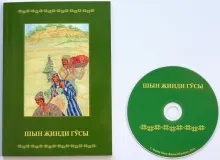Dungan
news-20032023
The Institute for Bible Translation is continuing its series of short "Stories of the Prophets" in the Dungan language, telling the story of biblical prophets who are revered by Muslims, Christians, and Jews alike. The newest books in the series are David and Solomon. The texts of the Dungan translation are accompanied by a parallel Russian text and colorful illustrations by the Dungan artist Khalida Shimova, who portrayed the biblical characters as closely as possible to the Dungan readers’ worldview, psychology, and way of life.
news-25052020
The Institute for Bible Translation has just expanded its Dungan-language Stories of the Prophets series with two publications that tell the stories of Moses and Jonah. This series relates the Biblical narratives about the greatest prophets that are revered by Jews, Christians, and Muslims alike.
The first installment of the series, Noah, appeared in 2016, followed by the stories of Abraham and Joseph in 2019. The Dungan stories are accompanied by a parallel Russian text and colorful illustrations produced by the talented Dungan artist Khalida Shimova. The biblical characters in these stories appear just as the Dungan reader would imagine them, in their own cultural environment and dressed in their traditional clothing. To aid the reading experience, each book is accompanied by an audio CD with a Dungan recording of the text. This is available on the IBT website in the audio recordings section.
news-140219
IBT has published another two Dungan-language editions from the series “The Lives of the Prophets”, this time on the stories of Abraham and Joseph from the book of Genesis. The first book in this series was the Noah story, published in 2016. The Dungan translations of the Abraham and Joseph stories are accompanied by a parallel Russian text, as well as by beautiful illustrations by Dungan artist Khalida Shimova and an audio recording on CD.
Language-support-0318

In 2014 the Institute for Bible Translation published the first translation of King Solomon's proverbs in the Dungan language. This book, compiled more than 2,500 years ago in Israel and now known to many peoples as part of the Holy Scriptures, teaches a proper attitude towards God and other people.
Whenever translators work on the book of Proverbs, they quite often discover parallels between the ancient proverbs and those in their own language. The Dungan language was no exception. F. Mashinkhayeva, who was involved in the IBT Dungan Bible translation project, spent many years collecting language material in her home village of Irdyk in the Issyk-Kul Oblast...
news-301116
IBT has published a new illustrated Scripture portion, the Noah story, in the Dungan language. The story of Noah and the Flood from the book of Genesis is the first publication in the “Lives of the Prophets” series that the Dungan translation team is working on following the popular edition of the Proverbs of Solomon (published in 2015). The Noah story is presented in parallel columns in Dungan and Russian and is illustrated by beautiful artwork produced by a Dungan painter. An audio CD with the recording of the story in Dungan is included with the book.
news-280116
The Institute for Bible Translation has published a beautifully illustrated selection of four parables from the Gospel of Luke in the Dungan language. The selection includes the Parables of the Good Samaritan (10:30-35), the Wedding Feast (14:16-23), the Prodigal Son (15:11-32), and the Pharisee and the Tax Collector (18:10-14), and comes with an audio recording of the text on CD.
new-pub-231015
IBT has recently published an illustrated edition of “Bible Stories” in the Dungan language, spoken primarily in Kyrgyzstan, Uzbekistan, Kazakhstan and China. This book is a short version of IBT’s beloved Children’s Bible that introduces readers to 58 stories from the Old and New Testament.
new-pub-210415
IBT has published the book of Proverbs in Dungan, a language closely related to Mandarin Chinese with influence from Arabic, Persian, Russian, Kyrgyz and other languages. About 110,000 Dungans live in Kyrgyzstan, Kazakhstan and Uzbekistan, with up to 10 million more in China. While Dungans in China use the standard Chinese writing system, since the 1920s Dungans in Central Asia have used a separate orthography, which was converted to Cyrillic letters in the early 1950s.
Language-support-1009













